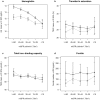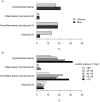A 3-marker index improves the identification of iron disorders in CKD anaemia
- PMID: 24586229
- PMCID: PMC3929276
- DOI: 10.1371/journal.pone.0084144
A 3-marker index improves the identification of iron disorders in CKD anaemia
Erratum in
- PLoS One. 2014;9(6):e100606
Abstract
Background: Iron disorders are common and complex in chronic kidney disease (CKD). We sought to determine whether a 3-marker index would improve the classification of iron disorders in CKD anaemia.
Methods: We studied the association between Hb level and iron indexes combining 2 or 3 of the following markers: serum ferritin (<40 ng/mL), transferrin saturation (TSAT<20%) and total iron binding capacity (TIBC<50 µmol/L) in 1011 outpatients with non-dialysis CKD participating in the Nephrotest study. All had glomerular filtration rates measured (mGFR) by (51)Cr-EDTA renal clearance; 199 also had hepcidin measures.
Results: The TSAT-TIBC-ferritin index explained Hb variation better than indexes combining TSAT-TIBC or ferritin-TSAT. It showed hypotransferrinaemia and non-inflammatory functional iron deficiency (ID) to be more common than either absolute or inflammatory ID: 20%, 19%, 6%, and 2%, respectively. Hb was lower in all abnormal, compared with normal, iron profiles, and decreased more when mGFR was below 30 mL/min/1.73 m(2) (interaction p<0.0001). In patients with mGFR<30 mL/min/1.73 m(2), the Hb decreases associated with hypotransferrinaemia, non-inflammatory functional ID, and absolute ID were 0.83±0.16 g/dL, 0.51±0.18 and 0.89±0.29, respectively. Compared with normal iron profiles, hepcidin was severely depressed in absolute ID but higher in hypotransferrinaemia.
Conclusions: The combined TSAT-TIBC-ferritin index identifies hypotransferrinaemia and non-inflammatory functional ID as the major mechanisms of iron disorders in CKD anaemia. Both disorders were associated with a greater decrease in Hb when mGFR was <30 mL/min/1.73 m(2). Taking these iron profiles into account may be useful in stratifying patients in clinical trials of CKD anaemia and might improve the management of iron therapy.
Conflict of interest statement
Figures
References
-
- Herzog CA, Muster HA, Li S, Collins MSA (2004) Impact of congestive heart failure, chronic kidney disease, and anemia on survival in the Medicare population. Journal of Cardiac Failure 10 (6) 467–472. - PubMed
-
- Stancu S, Stanciu A, Zugravu A, Bârsan L, Dumitru D, et al. (2010) Bone marrow iron, iron indices and the response to intravenous iron in patients with non-dialysis-dependent CKD. Am J Kidney Dis 55: 639–647. - PubMed
Publication types
MeSH terms
Substances
LinkOut - more resources
Full Text Sources
Other Literature Sources
Medical



